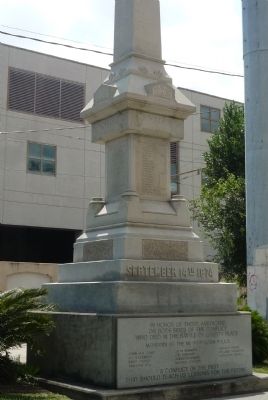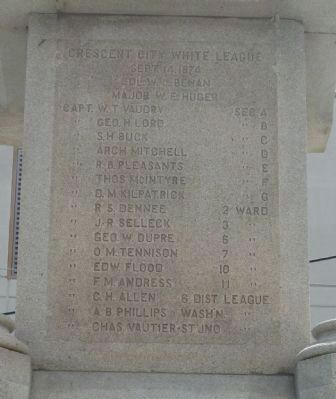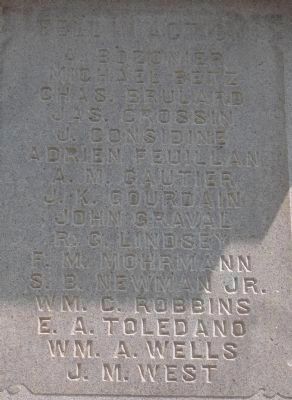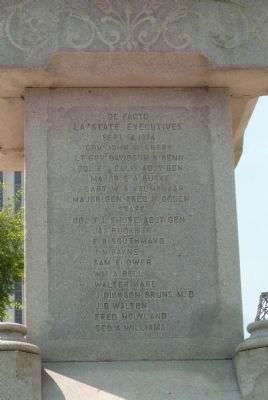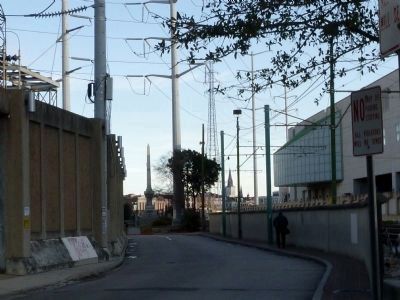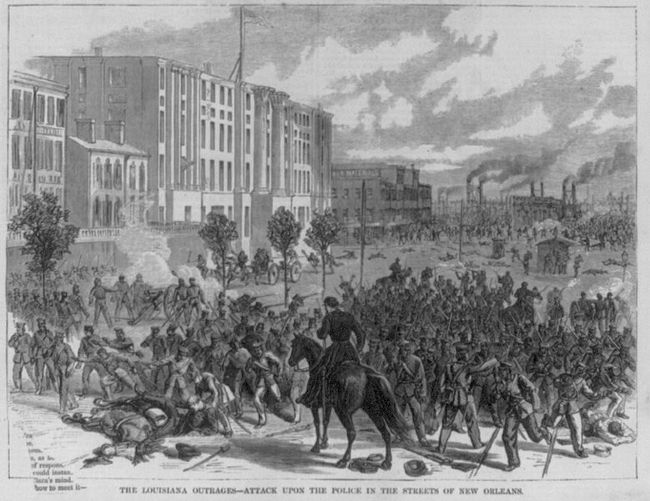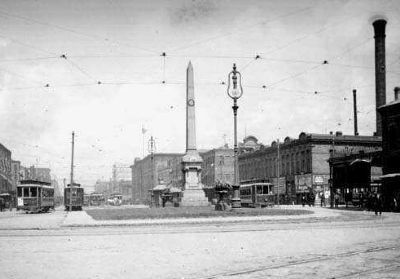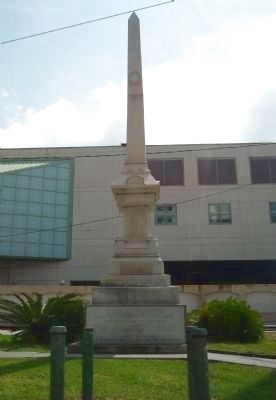French Quarter in New Orleans in Orleans Parish, Louisiana — The American South (West South Central)
Battle of Liberty Place Monument
"September 14th 1874"
[ inscriptions, west face, base :]
In honor of those Americans on both sides who died in the Battle of Liberty Place
Members of the Metropolitan Police:
John H. H. Camp John Kennedy Edward Simon J.F. Clermont J.E. Koehler William Thornton David Fisher James McManus Rudolphe Zipple Armsted Hill Michael OKeefe
A conflict of the past that should teach us lessons for the future.
[inscriptions, west face, upper:]
Sept. 14, 1874
Col. W. J. Behan Major W. E. Huger Capt. W. T. Vaudry, Sec. A Capt. Geo. H. Lord, Sec. B Capt. S. H. Buck, Sec. C Capt. Arch Mitchell, Sec. D Capt. R. B. Pleasants, Sec. E Capt. Thos. McIntyre, Sec. F Capt. D. M. Kilpatrick, Sec. G Capt. R. S. Dennee, 2 Ward Capt. J. R. Selleck, 3 Ward Capt. Geo. W. Dupre, 6 Ward Capt. O. M. Tennison, 7 Ward Capt. Edw. Flood, 10 Ward Capt. F. M. Andress, 11 Ward Capt. C. H. Allen, 6 Dist. League Capt. A. B. Phillips, Washn. League Capt. Chas. Vautier, St. Jno. League
[inscriptions, east face:]
A. Bozonier Michael Betz Chas. Brulard Jas. Crossin J. Considine Adrien Feuillan A. M. Gautier J. K. Gourdain John Graval R. G. Lindsey F. M. Mohrmann S. B. Newman Jr. WM. C. Robbins E. A. Toledano Wm. A. Wells J. M. West
[inscriptions, south face:]
Sept. 14, 1874
Col. Jno. G. Angell Major Jas. O. Hill Major Jno. Augustin Major G. LeGardeur Capt. Euclid Borland, A Co. Capt. Frank McGloin, B Co. Capt. ? Blanchard, C Co. Capt. A. Roman, D Co. Lt. F. L. Richardson, E Co.
Artillery
Capt. Jno. Glynn, Jr. Capt. H. D. Coleman Capt. J. P. Macheca Lt. E. A. Guibet
[inscriptions, north face:]
La. State Executives
Sept. 14, 1874
Lt. Gov Davidson B. Penn Col. E. J. Ellis, Adj. Gen Major E. A. Burke Capt. W. B. Krumbhaar Major Gen. Fred N. Ogden
Staff
Col. T. L. Shute, Adjt. Gen. Col. Jas. Buckner Col. F. R. Southmayd Col. J. N. Payne Col. Sam Flower Col. Wm. A. Bell Col. Walter Hare Col. J. Dickson Bruns, M.D. Col. J. B. Walton Col. Fred Holyland Col. Geo. A. Williams
Erected 1891 by City of New Orleans.
Topics. This monument and memorial is listed in these topic lists:
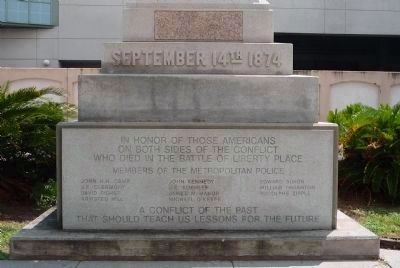
Photographed By Richard E. Miller, August 6, 2010
2. Battle of Liberty Place Monument - west face base inscriptions
--additions made to include casualties suffered by the racially integrated N.O. Metropolitan Police Department during the insurrection of 1874, action prompted by protests and the repeated vandalization of the monument which led to its removal from view during the 1990s.
Location. Marker has been permanently removed. It was located near 29° 57.073′ N, 90° 3.826′ W. Marker was in New Orleans, Louisiana, in Orleans Parish. It was in the French Quarter. Memorial could be reached from Iberville Street north of Canal Street. The monument was between Iberville Street and the railroad/streetcar right-of-way, one block north of Canal Street and the entrance to the Audubon Aquarium of the Americas. Touch for map. Marker was in this post office area: New Orleans LA 70130, United States of America.
We have been informed that this sign or monument is no longer there and will not be replaced. This page is an archival view of what was.
Other nearby markers. At least 8 other markers are within walking distance of this location. Visit Historic Algiers Point (about 500 feet away, measured in a direct line); Gαlvez Monument (about 500 feet away); Canal Street Historic District (approx. 0.2 miles away); United States Customhouse (approx. 0.2 miles
away); 114 Magazine Street (approx. 0.2 miles away); Bienville's Plantation (approx. 0.2 miles away); Bienville Monument (approx. Ό mile away); Importer's Bonded Warehouses - Henry Howard, Architect (approx. Ό mile away). Touch for a list and map of all markers in New Orleans.
Related marker. Click here for another marker that is related to this marker.
Also see . . .
1. Wikipedia: Battle of Liberty Place. ...In 1891, a year after the Democratic legislature passed a new constitution that essentially disfranchised most blacks, the city government, by then representing only its white constituents, erected the Liberty Monument to "commemorate the uprising." In 1932 inscriptions were added to the monument which attested to its role in the white supremacist movement. In the late 20th century, the monument was seen as a symbol of racism by many in the black and Italian communities. (White League veterans led a mob that lynched eleven Sicilian men in 1891.) After the monument had to be removed because of street work in 1989, many residents opposed its being restored and replaced. The city tried to negotiate removing the inscriptions.
Some people argued for its being restored at the original location. The content of the inscriptions was seldom discussed; rather, the issues were dealt with on technical grounds. Historic preservation officials argued for its replacement; others argued this was history which did not deserve continued commemoration (Submitted on August 22, 2010, by Richard E. Miller of Oxon Hill, Maryland.)
2. Reconstruction: a state divided. (Submitted on August 22, 2010, by Richard E. Miller of Oxon Hill, Maryland.)
3. Removal of the first of four New Orleans Confederate monuments begins with Liberty Place. "The Battle of Liberty Place monument was driven away in pieces around 5:35 a.m. Monday (April 24, 2017). Only a concrete base remained." (Submitted on April 24, 2017.)
Additional commentary.
1. Monument removed in middle of night.
Continuing the PC world we live in, this monument was removed to a warehouse by the City of New Orleans. Workers who took the monument down today were wearing bulletproof vests, military-style helmets and scarves that obscured their faces. Police were also on hand. The mayor commented "we will no longer allow the Confederacy to literally be put on a pedestal in the heart of our city."
Another great reason for this website capturing markers and monuments before they are removed, stolen or destroyed.
— Submitted April 24, 2017, by Mark Hilton of Montgomery, Alabama.
2. The inscription changed three times over the years.
This was a monument to white supremacy. It is import to note that history, and recognize the reason it was erected, and ultimately removed.
The following inscription was added in 1932:
McEnery and Penn having been elected governor and lieutenant-governor by the white people, were duly installed by this overthrow of carpetbag government, ousting the usurpers, Governor Kellogg (white) and Lieutenant-Governor Antoine (colored).
United States troops took over the state government and reinstated the usurpers but the national election of November 1876 recognized white supremacy in the South and gave us our state.
In 1974, the city government added an adjacent marker, which stated:
Although the "battle of Liberty Place" and this monument are important parts of the New Orleans history, the sentiments in favor of white supremacy expressed thereon are contrary to the philosophy and beliefs of present-day New Orleans.
When the monument was moved in 1993, some of the original inscriptions were removed, and replaced with new inscriptions that state in part:
In honor of those Americans on both sides who died in the Battle of Liberty Place ... A
conflict of the past that should teach us lessons for the future.
— Submitted November 17, 2019, by Scott Radish of New Orleans, Louisiana.
Additional keywords. insurrection; race riot; coup d'etat; "The largest street fight in American history"; John McEnery; Gen. James Longstreet; Gov. William Pitt Kellogg; carpetbaggers; law enforcement; freedmen.
Credits. This page was last revised on February 12, 2023. It was originally submitted on August 22, 2010, by Richard E. Miller of Oxon Hill, Maryland. This page has been viewed 9,057 times since then and 138 times this year. Photos: 1, 2, 3, 4, 5. submitted on August 22, 2010, by Richard E. Miller of Oxon Hill, Maryland. 6. submitted on February 9, 2014, by Allen Gathman of Pocahontas, Missouri. 7, 8, 9. submitted on August 23, 2010, by Richard E. Miller of Oxon Hill, Maryland. • Bill Pfingsten was the editor who published this page.
